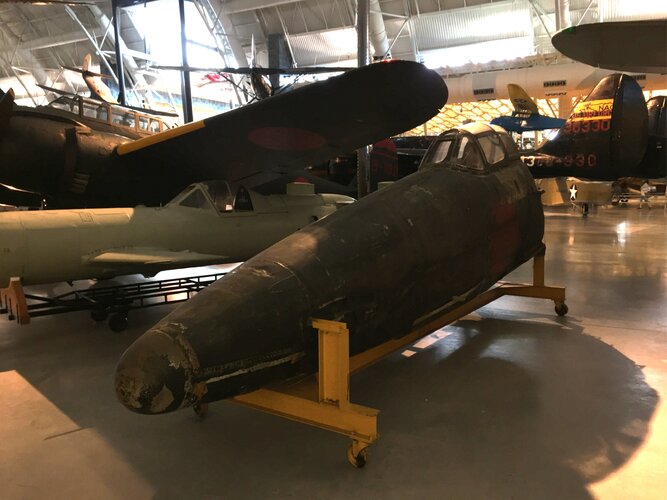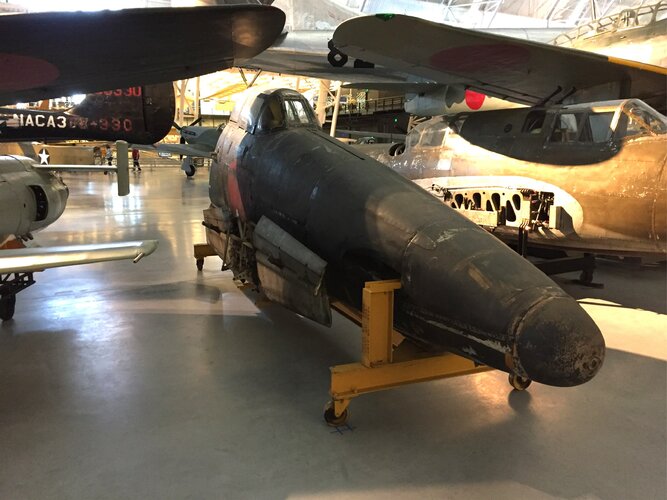My dear Tophe,
The J7W2 was a really project to japanese navy in my source.
The Nakajima J9N was also a really project developed from J8N
Kikka jet fighter.
Hello, Perhaps it's too late to ask and not talk about the main topics, but I want to know what the difference is between Nakajima's J9N and J8N jet fighters?
Kikka came to my attention via the designation "J9N"? (due to today's confusion), and many sources referred to the designation as "J9Y," but when I search on Google, Kikka is also listed as "J8N." Probably someone can help me. Thank you.
Nakajima Kikka/Kitsuka
Presented to the
Kaigun Koku Hombu on 14 September 1944, as a candidate to the
Kokoku Heiki No.2 project, the J9N1/MXN1 (speculative designations)
Maru-Ten was a suicide bomber armed with one (fixed) Number 80 Model 2 bomb of 807.5 kg. Lacking an undercarriage, it took off from a cart propelled by two
Toku-Ro.1 Type 2 rockets running over 200 m of rails.
As with the projected
Ohka 43-Otsu project of Kugisho, the
Maru-Ten was armed with two 13 mm Type 3 machine guns to defend from the Allied fighters. It also had foldable wings that could be hidden in caves and railroad tunnels. On September 1944 the IJN issued the ‘19-shi specification’ calling for a special attack bomber with 693 km/h max speed and 350 take-off run when using two 450 kgf RATOG bottles.
In November 1944, after a series of tests made with a
Betty bomber, it was concluded that the Ne-12B centrifugal turbojet, with only 320 kgf static thrust, did not produce anywhere near the power required to propel this aircraft that had a range of just 204 km, due to its high rate of fuel consumption of 510 kg/h.
On 9 December, the
Kaigun Koku Hombu decided to modify the project ‘19-shi special attack bomber’ into the 620 kph ‘anti-invasion’ fast bomber J9N2/MXN2 (speculative designations), propelled by two Yokosuka/Kugisho Ne-20 axial turbojets with 475-490 kgf static thrust, tricycle type landing gear, armoured windshield, automatic extinguisher devices and two Type 99, 20 mm cannon, but the weight of the (launchable) bomb had to be reduced to 500 kg.
With the possibility of using the Ne 20 axial turbojet, with only 62 cm of diameter, Nakajima proposed to
Kaigun Koku Hombu three possible configurations for the ‘anti-invasion’ fast bomber. The first proposal consisted of a twin boom airframe with two Ne 20 turbojets mounted on the upper and lower sides of the fuselage. In the second proposal, they were located under the wing roots; the third proposal was a variant of the
Maru-Ten with the engines mounted under the wings. The mock-up was presented to the IJN on 28 January 1945, receiving the official designation
Kikka/Kitsuka.
The first Nakajima/Yokosuka
Kikka (J9Y1 speculative designation) prototype was based upon the third proposal and flew for the first time on 7 August 1945. To gain some time, it was built with the main landing gear of an A6M5
Zero-Sen and the tailwheel of a P1Y
Ginga as a nosewheel.
First prototype technical data
Wingspan: 10 m, length: 9.25 m, height: 3.05 m, wing area: 13.2 sq. m, max weight: 3,950 kg, max speed: 677 km/h, service ceiling: 10,700 m.
The prototype was used as the basis for an emergency fighter project (J9Y2
Kikka-KAI speculative designation) powered by two Ne 20-KAI turbojets with 570-650 kgf static thrust and armed with a Type 5, 30 mm cannon. The wing area was extended to 14.51 sq. m for a 12,300 m service ceiling and a time to climb to 10,000 m of 20 minutes. The estimated maximum weight for this version was 4,152 kg and the maximum speed of 785 km/h.
The possibility of using the new Ishikawajima-Shibaura Ne 130 turbojets, with 900 kgf static thrust, allowed the design of an air-superiority fighter (J9Y3 speculative designation) with combat flaps and leading-edge slots to improve maneuverability, armed with four Type 5, 30 mm cannon. The protection for the pilot consisted of one 70 mm thick armored windshield and 12 mm steel plates at the back of the seat. The two fuselage fuel tanks of 330 and 425 liters were protected with 22 mm thick leak-proof rubber. The estimated maximum weight for this version was 4,232 kg and the max speed of 713 km/h
On 13 June 1945, the
Kaigun Koku Hombu decided the mass production of the special attack bomber and of the emergency fighter. At the time of Japanese surrender a second prototype was completed and 18 pre-production airplanes were in various stages of assembly. The third prototype
Kikka-K was a two-seat trainer/reconnaissance variant (J9K speculative designation) with 721 km/h estimated max speed.




























